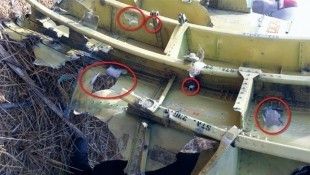
On the 9th of September 2014 the Dutch Safety Board issued the preliminary report on the investigation into the crash involving Malaysia Airlines, flight MH17.
In the video Tjibbe Joustra, chairman of the Dutch Safety Board explains the preliminary report.
‘The MH17 crash was a result of structural damage caused by a large number of high-energy objects that struck the Boeing from the outside, the preliminary report into the Malaysia Airlines disaster in Ukraine said.
“Flight MH17 with a Boeing 777-200 operated by Malaysia Airlines broke up in the air probably as the result of structural damage caused by a large number of high-energy objects that penetrated the aircraft from outside,” the Dutch Safety Board said in its preliminary report.

BYPASS THE CENSORS
Sign up to get unfiltered news delivered straight to your inbox.
You can unsubscribe any time. By subscribing you agree to our Terms of Use
Dutch investigators added that “there are no indications” that the tragedy was triggered “by a technical fault or by actions of the crew.”
Malaysian Transport Minister Liow Tiong Lai said on Tuesday that more analysis was needed to investigate the crash.
“We want to further analyze the data and the wreckage,” he said, adding that more details were needed so that the authorities “will bring the perpetrators to justice.”
The Malaysia Airlines plane en route from Amsterdam to Kuala Lumpur with 298 people aboard crashed in Ukraine’s Donetsk region on July 17. The majority of those on the plane – which was allegedly shot down – were citizens of the Netherlands.
Plane was ‘split into pieces during flight’
The cockpit voice recorder, the flight data recorder and data from air traffic control all suggest that flight MH17 proceeded as normal until 13:20:03 GMT, after which it ended abruptly.
The cockpit crew made no emergency call, the radio communications with Ukrainian air traffic control shows.
“The final calls by Ukrainian air traffic control made between 13.20:00 and 13.22:02 [GMT] remained unanswered,” the report said.
The plane was “split into pieces during flight,” the investigators said, based on the analysis of the pattern of wreckage on the ground.
The Dutch investigators said that “available images show that the pieces of wreckage were pierced in numerous places.”
The report emphasizes that investigators haven’t yet had the chance to recover the components for forensic investigation.
However, the photos taken from the wreckage “indicated that the material around the holes was deformed in a manner consistent with being punctured by high-energy objects,” the report said. “The characteristics of the material deformation around the puncture holes appear to indicate that the objects originated from the outside the fuselage.”
The fact that the plane was damaged from the outside “also explains the abrupt end to the data registration on the recorders, the simultaneous loss of contact with air traffic control and the aircraft’s disappearance from radar,” the report says.
The report says that the flight recorder was “found damaged but the internal memory module was intact.”
“The external damage found on the [flight data recorder] was consistent with impact damage.”
The radar data from the aircraft shows that “three commercial aircraft were in the same Control Area” as the Malaysia Airlines plane.
Dutch investigators concluded that the Malaysian airliner was flying “in unrestricted airspace above the restricted area mentioned by the latest NOTAM [Notice to Airmen].” Commercial flights were restricted in the area below the flight level of FL320, MH17 was flying at FL330.
Full report to be released ‘within a year of the crash’ – Dutch Safety Board
Tjibbe Joustra, chairman of the Dutch Safety Board, said that the plane tragedy in eastern Ukraine “shocked the world and raised many questions.”
“The initial results of the investigation point towards an external cause of the MH17 crash,” he said. “More research will be necessary to determine the cause with greater precision. The Safety Board believes that additional evidence will become available for investigation in the period ahead.”
Joustra said that the Dutch Safety Board’s full report will be published in summer 2015, “within one year of the date of the crash.”
In the meantime, the Russian Federal Aviation Agency said that the Dutch report marks the beginning of a thorough investigation of the plane crash.
“The investigation of the crash site and the wreckage should be an important part of this work,” said Oleg Storchevoy, the agency’s deputy head. “[We] need to investigate all the radiolocation data, perform forensic expertise…. Without this information one can’t speak of any preliminary conclusions concerning the tragedy.” ‘


